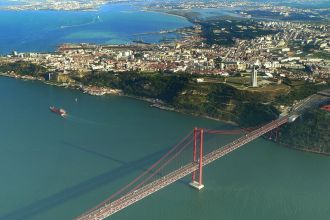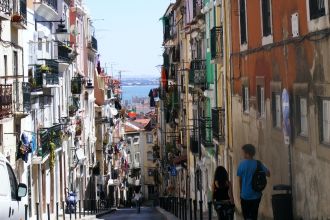
Lisbon

City Rating by visitors:
3.7/5
Options
Destination rating view details
Automatically saved - thank you.
You can change your score!
Lisbon Overview
Built on the seven hills, on the place where the River Tagus meets the Atlantic ocean, Lisbon is one of the most fascinating cities in Europe and is often considered a hidden gem. Lisbon, the capital of Portugal, is situated in a relatively small area of 84.6 square kilometers, at the same latitude as Washington D. C. (it is the closest European capital to the US) and has 564,657 inhabitants (more than 3 million inhabitants live around the city). Despite not being Mediterranean city (whole Portuguese coast is Atlantic), Lisbon enjoys a warm, Mediterranean climate with mild winters and very warm summers.
Read more about Lisbon
Strongly influenced by the Gulf Stream, among all the European cities, here are the warmest winters on the continent, with average temperatures above 15.2°C (59.4°F) during the day.
After Athens, Lisbon is the second European oldest capital and one of the oldest cities in the world. It is home to the world's greatest explorers like Vasco da Gama, Ferdinand Magellan and Henry the Navigator.
A little history...
Since 1200 BC Phoenician trading centre called Allis Ubbo („safe harbor“), later called Olissipo, had existed in the territory of later Lisbon. During the Punic wars Olissipo became a part of the Roman Empire with extensive privileges (called Felicitas Julia). Lisbon prospered under Roman rule and was one of the focal points of Christianity on the Iberian Peninsula. Around the year 711, Olissipo was conquered by the Moors, who ruled the city until 1147. Lisbon became the capital of Portuguese Kingdom more than a hundred years later - in 1255.
In the 15-16th century, during the Europe´s „Age of Discovery“, Portugal built up a great empire spreading over all continents, from South America (Brazil) to Africa, Asia (Macao, China; Goa, India) and Oceania. Lisbon became the capital of the first real world power.
In 1755, Lisbon was hit by a catastrophic earthquake which, together with subsequent fire and tsunami, destroyed most of the city (only Alfama district survived). About 100 000 inhabitants had died.
The perfect itinerary for 3 days what to see in Lisbon:
You shouldn´t miss in Lisbon:
- Tower of Belém - fortified Tower from 16th century, the UNESCO World Heritage Site, is located on the bank of the Tagus River. It is a great work of the Manueline architectural style, developed in the Age of Discoveries to commemorate Vasco da Gama’s expedition to India.
- Jerónimos Monastery - UNESCO World Heritage Site, founded in 1501. Beside the stunning exterior and interior you can see there e.g. tomb of King Manuel I. and gravestones of Vasco da Gama.
- Padrão dos Descobrimentos (Monument to the Discoveries) - 50-meter high monument located in Belem, at the bank of the Tagus River, commemorates the famous era of Portuguese sailors in the “Age of discovery”.
- Castle of São Jorge (Saint George Castle) - the Moorish Castle located on the hill above the historic city centre offers impressive view with a cosy atmosphere.
- Lisbon Oceanarium - one of the world's largest aquariums shows about 25,000 fish, seabirds, and mammals.
- Fado music experience - Have dinner in the oldest Lisbon´s district Alfama and listen Fado music (melancholic songs from the 19th century)! Fado was awarded World Heritage status.
- Portuguese cuisine experience - Book a table in one of many fish restaurants. For all fresh fish-lovers it is an unforgettably delicious paradise! (TIPS: see the page "Restaurants")
Maybe you didn´t know that...
- Lisbon is older then Rome.
- Lisbon’s Vasco da Gama Bridge is the longest bridge in Europe (17,2 km).
- The typical trams in Lisbon is in reality an American product.
- Only 5 men know the recipe to the Lisbon’s favourite pastry "Pastel de nata".
- Benfica football club is listed in the Guinness Book of Records for having the largest number of fans for any one football club: an estimated total of 14 million worldwide.
- Is doubtful that Lisbon was built on 7 hills - in reality these 7 hills were never very historically accurate and were (mis-)counted, possibly on purpose just to make the city more similar to Rome.
Read less about Lisbon ↑


Sights & culture
The UNESCO World Heritage Site, 35 metres high fortified Torre de Belem is located on the bank of the Tagus River. It is one of...

Sights & culture
Located on the northern bank of the Tagus River, near Tower Belem and Jéronimos Monastery, the Monument to the Discoveries...

Sights & culture
Designed by American architect Peter Chermeyeff, Lisbon's Oceanarium is one of the world's largest aquariums. It is located in the...

Sights & culture
Located on the top of the highest hill in Lisabon historic centre, above the old Moorish quarter, St. George Castle is visible...
Comments
































Renata 190 points
Wonderful city especially for lovers of fresh fish!
02.12.2014
» close full review
Taxi geneva 40 points
The 7 hill city
31.10.2016
» close full review
Gerard 25 points
A Great Experience
03.07.2017
» close full review